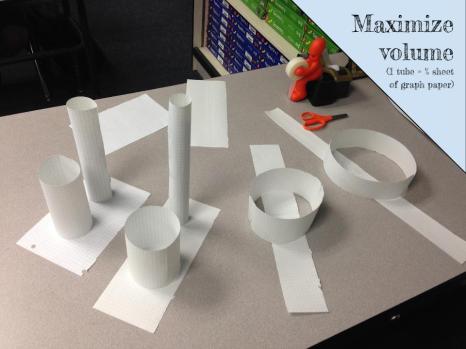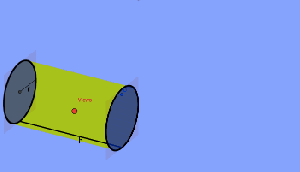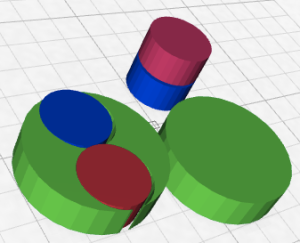Simple questions with not so simple answers have been growing in the classroom. I’ve seen multiple takes on the classic “which glass has more” from Piaget, to Meyer, Timon Piccini, and I’m sure plenty of others. I figured we could also do the same type of thing lo tech style.
Hook:
You have to use half of a standard size sheet of paper. What is the largest cylinder you can make ignoring the top and bottom lids (bases).

In other words, paper = lateral area.
There are at least 2 ways of splitting a sheet of paper. Many teachers refer to them in similar foods:
 versus
versus  ,
,  versus
versus , or whatever else the students can come up with. I started this prompt with my first class and quickly had to apply some planned scaffolding.
, or whatever else the students can come up with. I started this prompt with my first class and quickly had to apply some planned scaffolding.
Mr. Butler we don’t know the radius? Can we use a ruler? What is the height? and of course…I don’t get it.
We rebooted and brainstormed what we did know about what we had:
- The base is a circle
- The wall (lateral area) rolls out to be a rectangle
- Area of a Circle = Pi*r^2
- Circumference of a Circle = 2*Pi*r
After the students got this out there was still a connection missing. There was no mention of dimensions of a piece of paper. I asked if they would like to know how big a sheet of paper was. Students were quick to realize that this would help with calculating the height, so they pleaded with an almost sarcastic whine, “Please!?” After telling them standard american sheets of paper are 8.5 x 11 inches, they still struggled with making the connection to the radius. I showed the students one example for finding the radius using the base edge as a circumference and working backwards. By now half the period was over and not much progress had been made in answering the question (save for the on visual approximations without measure).
After one period of work we were able to ask a question, make some attempts at a reasonable answer, and reach absolutely no conclusions.
Enter the next class.
Modifications are a necessary part of teaching and learning. Fit teachers truly survive through refinement and adaptation. For this activity I narrowed our resources to be more specific with using only graph paper. This removed the required knowledge and/or tools for measuring edges of a rectangular piece of paper. Students could simply count. Some students were wanting clarification on what the units actually were, “Mr. Butler are these little squares the same as centimeters? Or something else?” I replied with, “Let’s call them units for our activity,” and eventually whispered, “Most graph paper sheets we use are split into quarter inches.” I made a mental note to include varying sizes/scale of grid squares for future attempts at this question. Students could see that the geometrical relationships are not dependent on actual units as long as one is consistent.
The questions in this class were more closely targeted at the actual question of which cylinder was bigger.
- I can use the grid to measure the height but how do I find the radius?
- Do I even need to find the radius? Can I answer the question with just the height and the size of the paper?
- Can I use the grid to measure the radius?
- Mr. Butler, I can just stand up the cylinder like this and look down. I can see the radius across the inside. Can I just use this to measure it? (He was referring to the diameter, but I got the point, more importantly this caused me to determine the point of the whole activity:
Am I trying to
- increase fluency and familiarity with the formulas for surface area and volume of a sphere? …or…
- practice using a tool (grid paper) appropriately and apply problem solving?
So I had a little micro conference with the opposing arguments on my shoulders:
| Procedural Thinking |
Problem Solving |
Practice with the formulas.
The abstract concept will apply to any situation.
Students can’t use grid paper on the standardized test |
Encourage and support practical application.
Using tools appropriately is a universal skill.
Life beyond high school will depend more on tools than abstract concepts. |
From experience in the classroom I chose the most classical teaching strategy I know: stall with a question, “How ’bout you try it an tell me what you find.” I didn’t want other tables to just settle solely with the approximation of the radius with the grid paper, so I continued to prod each group as I circulated for alternative methods. After 10 or so minutes of struggle I could see the class needed a bone thrown in its direction.
Alright, let’s try to see if we can calculate one of these cylinders using something we know about the lateral area. I displayed an animation we looked at when first expoloring a conceptual understanding of surface area of a cylinder.
T: So which edge helps us with the height?
S: The height. (said with a tone implying, “Duh”).
*Side note: This question was pretty elementary, with more of an intention to rule out one edge and focus on the other. There’s probably a better way to set that up with answering my own question.
T: Awesome, anything worth mentioning about the other edge?
Crickets. Wait time. Wait for it.
S: “The diameter?”
T: Thank you, but I’m not sure, let’s see. So if this rectangle edge is the diameter, then it should be the same rolled up and laid flat. What do you think?
S: Oh, no, not really.
Crickets. Wait time. Wait for it. Wait…
S: whispers, “I’m not sure, I think so”
T: “Go ahead, it’s better to try something than just sit and wait.”
S: mumbles, “circumference?”
T: hand up to ear, “Say again?”
S: Circumference. (Stated, slightly more confident).
T: Let’s see, what do we know about circuference…
From here with the help of a few different students we’re able to breakdown the measure of the radius after knowing the circumference. Then calculate the volume with said radius. This is one of at least 4 calculations needed for the process. I leave the work up at the board and recirculate constantly repeating the actual question, “Which one is bigger?”
More than half the class reaches a conclusion in the next 5 minutes. They determine out of the four that the widest cylinder is in fact the largest. For a group that reached this result significantly faster than the others I challenged them to answer if a cylinder half as tall as the widest cylinder and again using the same lateral area would be larger or small. A simple construction and then comparison of fitting the taller of the 2 cylinders into the half as tall cylinder twice with room to spare answered the question with simple visual reasoning:
Reflection:
I was much more satisfied with the second experience, and now as I’m writing this I have an even better question to help the students generalize the reasoning as well as increase number sense with the calculation:
What matters more in the volume of a cylinder? The radius or the height?
Is it the same for Surface Area?
The necessary argument for these would call for the students to use examples from their activity and articulate a conclusion with at least a minimally satisfying level of reasoning. Maybe next time I’ll include a state for putting together the data into a graph to help students see relationship.
Why does this even matter? Ask yourself about packaging. Why does it make sense to use cylinders? Why would one want to optimze volume? Why might materials be restricted? I’m writing this as I just finished a beverage that was served in a glass that makes me consider the intent of its design. Did I really get the most out of my drink?
![]() versus
versus ![]() ,
, ![]() versus
versus![]() , or whatever else the students can come up with. I started this prompt with my first class and quickly had to apply some planned scaffolding.
, or whatever else the students can come up with. I started this prompt with my first class and quickly had to apply some planned scaffolding.


